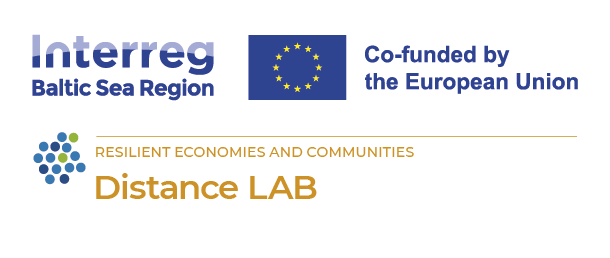Club Distance Lab
To organize an online community-building event for entrepreneurs Club Distance Lab, organizations can follow this detailed methodology:
CONCEPT FOR THE EVENT
The purpose of this event is to build community among the companies that are connected in some way – develop their business in the same building, belong to a business incubator or some start-up club, etc. The main organizer of the event is a dedicated person from the organization that unites the companies, for example, a Community Coordinator. The first part of the event is for the representative of organizers to overview current issues, and upcoming events if any, and to overview Club Distance Lab Agenda for that day. The event then starts with new companies in the community introducing themselves (what they do, if they are looking for some kind of cooperation), then some of “old” companies present their new projects, maybe challenges that they encounter. The last part of the event is dedicated to some current topic that requires an outside speaker – a professional on the topic. Some of the topics can include intellectual property issues, cyber security issues, artificial intelligence issues, and so on.
The event lasts for approximately 1-1,5 hours. After the event participants receive an up-date letter with the video recording.
The event should be managed in all stages and should have a continuum as part of the overall event. Each of the stages of an event needs to be carefully and strategically thought of. The stages should include the:
- Preparatory stage for the event (key points: participants’ readiness to network, selection of participants, well-structured presentations);
- A well-managed event (key points: uniqueness of each event, variety of activities, cozy environment, post-event meeting options);
- Post-event meet-up(s) (key point: involvement of event participants in the mentored post-event contact development activities).
ORGANIZERS
Business support organization
Business incubator
Science and technology park
TARGET GROUPS
SMEs
Entrepreneurs
People thinking about creating a SME or a start-up
ORGANIZING THE EVENT
PREPARATORY STAGE
Identifying the Speaker(s):
Identify key topics for the event, survey the participants.
Focus on entrepreneurs, start-ups, researchers, and large corporations in the sector.
Select speakers who are industry leaders, innovators, and successful entrepreneurs.
Participant Readiness:
Agree with new members for a short presentation of their business.
Ensure participants are ready to network and collaborate.
Offer pre-event workshops or resources to prepare participants for effective networking.
Communication and Promotion:
Utilize social media, e-mail newsletters, and industry forums to promote the event.
Registration Process:
Implement a registration process to gather information about participants. During registration participants should identify if they are new members and will make a presentation introducing themselves or they are current members and would like to present their challenge or solution.
Select participants based on their potential for collaboration and contribution.
DURING EVENT
Unique and Engaging Format:
Schedule a mix of keynote speeches, panel discussions, and networking sessions.
Incorporate interactive elements like Q&A sessions, polls, and breakout rooms.
Cozy and Inclusive Environment:
Create a virtual environment that is welcoming and encourages open communication.
Provide guidelines for respectful and constructive interactions.
Technology and Platform:
Choose a reliable and user-friendly virtual event platform.
Ensure technical support is available throughout the event.
Agenda:
Begin with a welcome address and overview of the event’s purpose.
Schedule speaker sessions focusing on innovation, technology trends, and case studies.
Include networking breaks for participants to connect.
POST-EVENT ACTIVITIES
Feedback and Evaluation:
Collect feedback from participants to improve future events.
Analyze the outcomes and success of networking and collaborations initiated.
Follow-Up Meetings:
Encourage participants to organize follow-up meetings to explore partnerships and investment opportunities.
Provide a platform or channel for participants to schedule these meetings.
RESOURCES NEEDED
Staff costs and other administration costs. Human resources. A team of 3 members: networking consultant/moderator, communication expert, and event assistant.
Collaboration with other business intermediary organizations to expand the event’s reach.
Lector contacts
Target group contacts
TOOLS
Teams
Zoom
Google meets
Social media channels (Facebook, LinkedIn)
Google Forms
TEMPLATES
Key topics survey
Presentation template
Templates for social media campaigns
Registration template
Agenda of the event
Participants feedback survey template
USEFUL TIPS
- Regular Scheduling. Plan these events regularly (e.g., bi-monthly) to maintain engagement and momentum. Update the format and content based on industry trends and feedback. This works on promoting its image of a prestigious and, mostly, productive event.
- Community Building. Foster a community around these events for ongoing interaction and support. Use social media groups or forums for continuous engagement. It is very important to keep participants engaged in the follow-up activities (the last stage of the event) because this stage brings most of the tangible results that can be achieved.
- Adaptation and Expansion. Adapt the framework for different sectors or regions as needed. The framework of Club Distance Lab can be easily transferred to any other region. Each business intermediary organization depending on its profile, mission, and pool of clients can apply it. By organizing the “Club Distance Lab” organizations can tackle challenges in the various sectors – ICT, medicine, space technologies, robotics, and many others. This format can be adapted to the needs of other economic sectors and connect all relevant stakeholders.
- Club Distance Lab is built on the good practice of dominant business networking events. The strong point of this framework is that the event is managed in all its stages with the aim that participants would leave with tangible results. Additionally, this good practice seeks to strengthen the approach that networking is not just a socialization, networking attitude should be based on accurate planning, purposeful solutions, and continuity.
This methodology and the practical tools provided can guide you to create a successful online event that not only facilitates networking and collaboration but also results in tangible outcomes for participants. The key is to manage all stages of the event strategically, ensuring engagement, and providing value to all involved.

